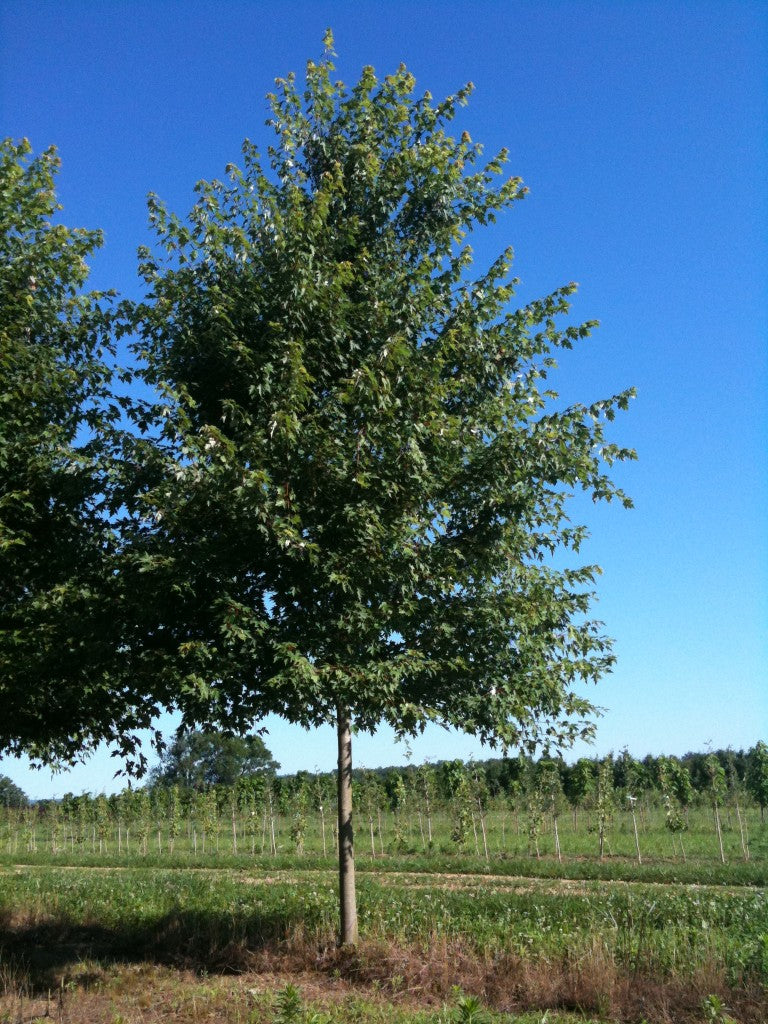Riverdene Garden Centre
Sienna Glen Maple
Sienna Glen Maple
Couldn't load pickup availability
Sienna Glen® Maple (Acer × freemanii ‘Sienna’) Care Guide
Overview:
-
Sienna Glen® is a hybrid maple (Freeman maple cross) known for combining the hardiness and adaptability of silver maple with the better form and fall color of red maple.
-
It tends to have a strong central leader, good branch structure, and fewer broken limbs compared to some maple hybrids.
-
Its fall foliage is quite striking, often showing a mix of yellow-orange to burgundy red.
Key Specifications
| Feature | Typical Value |
|---|---|
| Hardiness | Zone 3 (cold hardy) |
| Mature Height | 40–50 ft (some sources up to 50 ft) |
| Mature Spread | ~ 35–40 ft |
| Growth Habit / Form | Upright pyramidal when young; eventually more oval / pyramidal-oval |
| Foliage | Medium green in summer; fall color includes orange, red, burgundy |
| Fruit / Seeds | Mostly seedless or very few samaras (less “messy”) |
Planting & Site Conditions
-
Light: Full sun is ideal. Partial shade is tolerated but may reduce fall color intensity.
-
Soil: Prefers well-drained soils. It is tolerant of alkaline, clay, or wet soils to some degree.
-
Moisture: Moderate moisture preferred. While it tolerates occasional flooding or drought once established, consistent moisture especially in early years is beneficial.
-
pH / Tolerance: More tolerant of alkaline soils than many maples.
-
Spacing: Plan space for its mature canopy — give it room on all sides to expand (35–40 ft spread).
Watering & Establishment
-
During the first 1–2 seasons, keep soil moist (but not waterlogged). Frequent deep watering is better than light, frequent watering.
-
Mulch around the base (2–3 in) to conserve moisture, suppress weeds, and buffer soil temperature. Keep mulch a bit away from the trunk to prevent rot.
-
Once established, supplemental water during dry spells improves performance and fall color.
Fertilizing
-
In early spring, use a balanced slow-release fertilizer (e.g., 10-10-10) to support growth.
-
If soil is already rich, minimal additional fertilization is needed.
-
Avoid excessive nitrogen which may lead to weak, soft growth.
Pruning & Maintenance
-
Timing: Late winter to early spring (dormant) is best for structural pruning.
-
Techniques:
-
Remove any dead, diseased or crossing branches.
-
Maintain the central leader and good scaffold structure.
-
Thin interior branches to improve light penetration and airflow.
-
Avoid heavy pruning into old wood, as maples may struggle to regenerate from deep cuts.
-
-
Because Sienna Glen has better branch structure and form than many hybrids, it often requires less frequent corrective pruning than, say, Autumn Blaze® cultivars.
Pests, Diseases & Issues
-
Tar Spot (Rhytisma sp.): Aesthetically undesirable but usually not harmful.
-
Leafhoppers, scale, aphids: Occasional insect pests. Monitor foliage; manage with insecticidal soap or systemic treatments if needed.
-
Suckers: May arise from pruning wounds or stress. Prune them out to maintain clean form.
-
Verticillium Wilt: As with many maples, sudden branch dieback (“flagging”) may indicate vascular disease—seek professional diagnosis if observed.
Winter / Cold Protection
-
Sienna Glen is quite cold-hardy, so in Saskatchewan it should generally survive winters without special protection.
-
For young trees or in exposed locations:
-
Use trunk guards or wrap lower trunk (especially against sunscald).
-
Apply a thicker mulch layer in late fall to buffer root zone against freeze-thaw cycles.
-
Landscape Uses
Excellent as a shade / street / specimen tree
Works well in urban or boulevard plantings due to its tolerance of soil and environmental stress
One of the more “clean” maples (less fruit drop) making it suitable for near sidewalks or patios
Its fall color adds ornamental interest in both residential and institutional landscapes
Photo from Wilson Nurseries
Share


